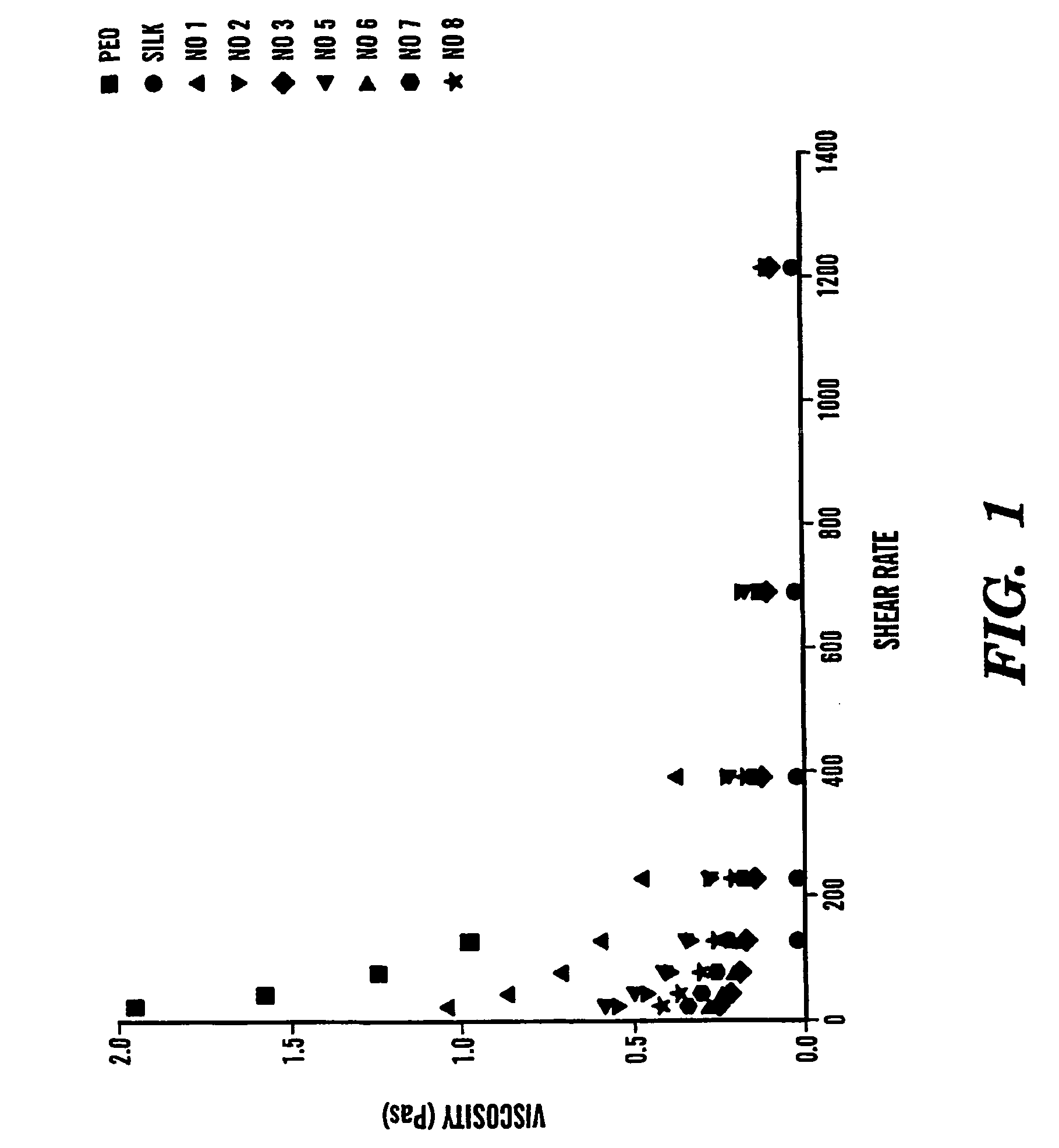Silk biomaterials and methods of use thereof
a biomaterial and silk technology, applied in the field of silk biomaterials, can solve the problems of embrittled materials, biocompatibility problems, and the process of electrophoresizing silk fibers for biomedical applications is complicated and laborious
- Summary
- Abstract
- Description
- Claims
- Application Information
AI Technical Summary
Benefits of technology
Problems solved by technology
Method used
Image
Examples
example i
Materials
[0070]Cocoons of B. mori silkworm silk supplied by Institute of Sericulture, Tsukuba, Japan. PEO with an average molecular weight of 4×105 g / mol and 9×105 g / mol (Aldrich) were used in blending.
Preparation of Regenerated B. mori Silk Fibroin Solutions
[0071]B. mori silk fibroin was prepared as follows as a modification of our earlier procedure [25]. Cocoons were boiled for 30 min in an aqueous solution of 0.02 M Na2CO3, then rinsed thoroughly with water to extract the glue-like sericin proteins. The extracted silk was then dissolved in 12 M LiBr solution at 60° C. yielding a 20% (w / v) solution. This solution was dialyzed in water using a Slide-a-Lyzer dialysis cassette (Pierce, MWCO 2000). The final concentration of aqueous silk solution was 3.0 to 7.2 wt %, which was determined by weighing the remaining solid after drying. HFIP silk solution (1.5 wt %) was prepared by dissolving the silk fibroin produced after lyophilizing the aqueous silk solution into the HFIP.
Preparation ...
example ii
Materials
[0084]Cocoons of B. mori silkworm silk were obtained from M Tsukada, Institute of Sericulture, Tsukuba, Japan. PEO with an average molecular weight of 9×105 g / mol and polyethylene glycol (PEG) (3,400 g / mol) were purchased from Aldrich and used without further purification.
Preparation of Regenerated B. mori Silk Fibroin Solutions
[0085]B. mori silk fibroin solutions were prepared by modifying the procedure described earlier [25]. Cocoons were boiled for 30 min in an aqueous solution of 0.02 M Na2CO3, then rinsed thoroughly with water to extract the glue-like sericin proteins. The extracted silk was then dissolved in 9.3 M LiBr solution at room temperature yielding a 20 wt % solution. This solution was dialyzed in water using a Slide-a-Lyzer dialysis cassette (Pierce, MWCO 2000) for 48 hrs. The final concentration of aqueous silk solution was 7.0 to 8.0 wt %, which was determined by weighing the remaining solid after drying.
Preparation and Treatment of Blend Films
[0086]Various...
example iii
Methods
[0102]Cocoons of B. mori silkworm silk were kindly supplied by M. Tsukada, Institute of Sericulture, Tsukuba, Japan. PEO with an average molecular weight of 9×105 g / mol (Aldrich) was used in the blends.
Preparation of Silk Matrices and Regenerated B. Mori Silk Fibroin Solutions
[0103]To prepare the silk matrices for cell seeding experiments, white Brazilian raw Bombyx mori silkworm fibers were extracted for 1 hour at 90° C. in an aqueous solution of 0.02 M Na2 CO3 and 0.3% (w / v) detergent as previously described [33] to remove sericin, the antigenic glue-like proteins that encapsulate the fibroin fibers following secretion from the silkworm. A 3-cm long silk wire-rope matrices consisting of 540 silk fibers (pre-extraction) were generated for use in this study by crimping ends with stainless steel 316L collars (1 cm in length, 2.2 mm I.D, 3 mm O.D.).
[0104]Regenerated B. mori silk fibroin solutions was prepared as a modification of our earlier procedure. Cocoons were boiled for 3...
PUM
| Property | Measurement | Unit |
|---|---|---|
| diameter | aaaaa | aaaaa |
| thickness | aaaaa | aaaaa |
| temperature | aaaaa | aaaaa |
Abstract
Description
Claims
Application Information
 Login to View More
Login to View More - R&D
- Intellectual Property
- Life Sciences
- Materials
- Tech Scout
- Unparalleled Data Quality
- Higher Quality Content
- 60% Fewer Hallucinations
Browse by: Latest US Patents, China's latest patents, Technical Efficacy Thesaurus, Application Domain, Technology Topic, Popular Technical Reports.
© 2025 PatSnap. All rights reserved.Legal|Privacy policy|Modern Slavery Act Transparency Statement|Sitemap|About US| Contact US: help@patsnap.com



